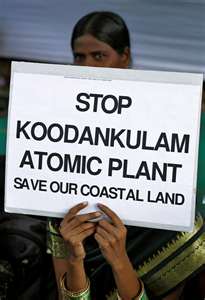 |
| India: Nuclear Power Plants Map from DiaNuke.org |
Article Highlights
- India's ambitions include a tenfold increase in nuclear power so it supplies 25 percent of the nation's energy needs by 2050. Two 1,000-megawatt nuclear reactors at Koodankulam are expected to go online very soon -- the first commissioned reactors since Fukushima.
- The People's Movement Against Nuclear Energy has successfully mobilized tens of thousands of Indian citizens to join nonviolent protests, while the Indian state has resorted to harassment and threats of violence.
- The nuclear establishment is the darling of Indian statehood, with far more people employed by the nuclear industry than the renewable energy sector. Citizen calls for increased transparency, accountability, and proper adherence to procedure have been met with repeated denials, deferrals, and deceit.
India has come into its own, a once-sleeping tiger waking with a
seismic roar. In the last two decades, India has emerged as a robust
modern military force, a formidable science and technology hub, and a
soaring economic success despite the global recession. These
developments, however, are accompanied by more and more demand for, and
reliance on, nuclear power -- and lots of it.
 |
| Indians protest against nuclear power plants. |
In fact, India's ambitions PDF
include a tenfold increase in nuclear power so it supplies 25 percent
of the nation's energy needs by 2050. Two reactors at the Koodankulam
Nuclear Power Plant in Tamil Nadu -- built by the Nuclear Power
Corporation of India Ltd. in collaboration with the Russian
Atomsroyexport -- are expected to go online in coming months. The
1,000-megawatt reactors are the first to be commissioned after the
Fukushima-Daiichi nuclear disaster in March 2011. Disconcertingly,
India's new coastal reactors are situated in an environment
similar to that of Fukushima -- a tsunami and earthquake zone, with the
addition of karst formations, geothermal irregularities, and a lack of
emergency water supplies.
India's strides in the nuclear sector have not come without resistance. The People's Movement Against Nuclear Energy (PMANE) -- formed in 2003 and now led by the scholar S.P. Udayakumar and two Jesuit priests -- has successfully mobilized tens of thousands of Indian citizens. And as more and more people realize the dangers a nuclear reactor could bring to the south Indian peninsula, the PMANE cause grows. Activists have stuck diligently to nonviolent protests -- inspired by Mohandas Gandhi -- and managed to stall construction of the Koodankulam plant for six months; the Indian state, on the other hand, has resorted to harassment and threats of violence. (Continue reading.....Nuclear power vs. people power
photo 1http://uk.images.search.yahoo.com/r/_ylt=A0S0uD8KFv1PxXEArMJWBQx.;_ylu=X3oDMTBpcGszamw0BHNlYwNmcC1pbWcEc2xrA2ltZw--/SIG=11u921d6e/EXP=1342015114/**http%3a//www.dianuke.org/india-nuclear-maps/
photo 2 http://cdn.bikyamasr.com/wp-content/uploads/2012/03/India-Nuclear-protest.jpg
photo 3 https://blogger.googleusercontent.com/img/b/R29vZ2xl/AVvXsEgQ9e18KNFG_33XRgRhJa44TDf5ihs2usR3jaJi1b1FbxHTitxTHuM0h6-LBgtHs164AvOJgmE-frlU1g6UHsIOQHBeZKgnzB04KqyFMoXda6zYTzgtrPear7jEnccwDisuaYmprU201q5k/s1600/Tamil+Nadu+Nuclear+Plant+Protest5.jpg

No comments:
Post a Comment